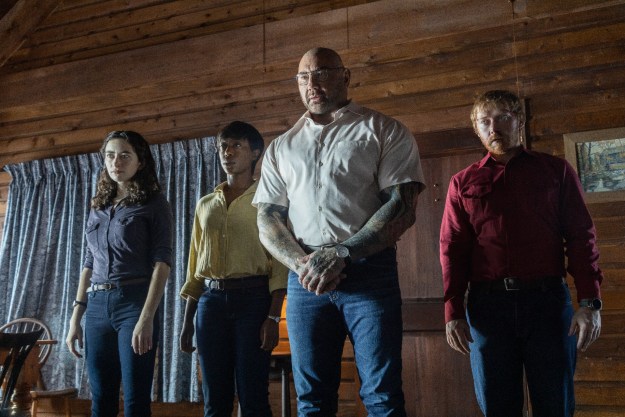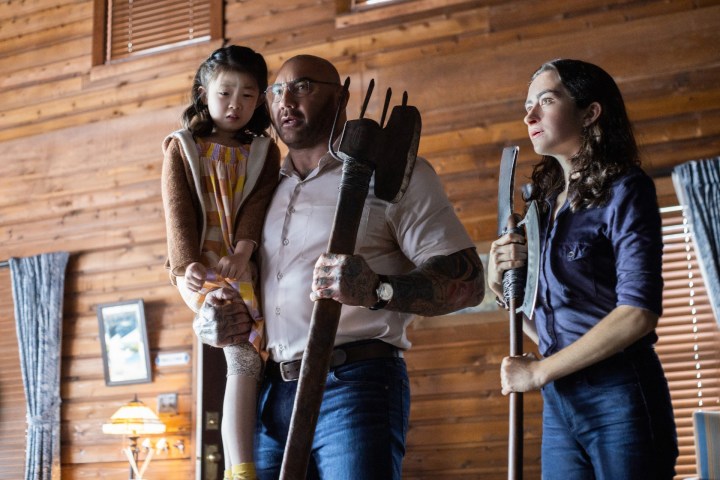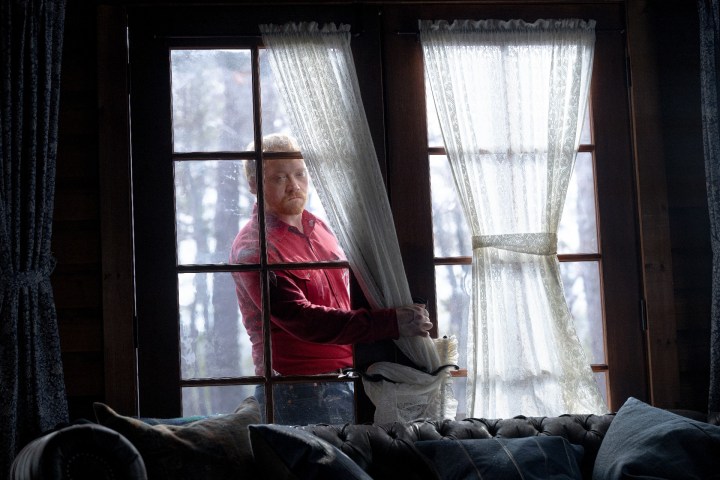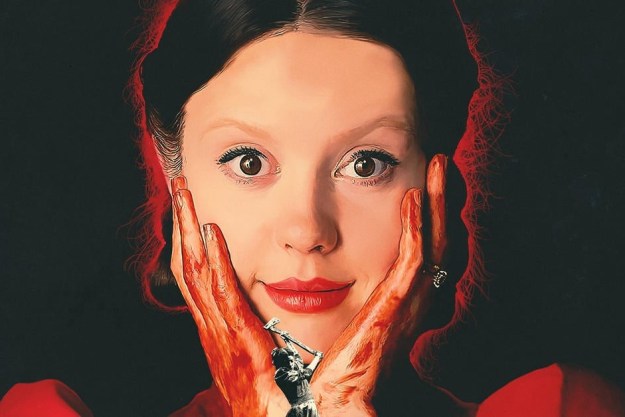
“Knock at the Cabin standout Dave Bautista elevates M. Night Shyamalan's apocalyptic thriller.”
- Great performances from the cast, especially Dave Bautista
- Fast pace keeps tension high and mounting throughout
- Heavy-handed religious themes undercut film's mystery
Filmmaker M. Night Shyamalan’s career has been a roller coaster of sorts. A string of early, successful thrillers fueled his ascent to the realm of Hollywood’s hottest directors, only to have a few high-profile, big-budget flops bring his cachet crashing back down to earth. In recent years, a series of smaller, critically praised projects has put him back on a more gradual climb, and his latest film, Knock at the Cabin, is poised to bolster that momentum.
Although it doesn’t quite meet the high bar set by his best work, the powerfully tense Knock at the Cabin is lifted by strong performances by its cast — particularly Guardians of the Galaxy Vol. 3 actor Dave Bautista — that sell its fantastic premise and keep you guessing as the brutal saga plays out.

No choice at all
Written and directed by Shyamalan and adapted from Paul G. Tremblay’s novel The Cabin at the End of the World, Knock at the Cabin doesn’t waste any time building up tension. The film opens with a young girl, Wen (Kristen Cui), catching grasshoppers in a secluded forest. Her efforts are interrupted by the arrival of a massive, but soft-spoken stranger, Leonard (Bautista), who walks out of the woods and makes friendly conversation with her before indicating that his heart is broken by the task set before him.
Things move quickly from that point, as Leonard is joined by three more strangers, each of them wielding savage weapons cobbled together with tools and garden implements. They descend upon the cabin where Wen is staying with her parents — Eric (Jonathan Groff) and Andrew (Ben Aldridge) — and force their way in, eventually explaining to the trio that they must make a terrible decision: either sacrifice one member of their family or all of humanity will perish in an escalating series of apocalyptic events.
The story puts Leonard’s group and Wen’s family on opposite sides of a seemingly impossible dilemma, as no amount of rational explanation by the former will convince the latter to do the unthinkable, even as one catastrophe after another ravages the world outside the cabin.

Bravo Bautista
While Groff and Aldridge’s performances are the emotional heart of Knock at the Cabin, it’s Bautista who makes the film’s central mystery work. Are Leonard and his group of apocalypse truthers — played by Rupert Grint, Nikki Amuka-Bird, and Abby Quinn — dangerously deluded or are they really harbingers of the end times hoping to save humanity?
Bautista’s Leonard is a massive, tattooed giant of a man who otherwise speaks and acts like the gentle, second-grade teacher he professes to be. Simultaneously frightening and sympathetic, scary and huggable, Goliath and David, Leonard is a jarring juxtaposition that ensures you’re never quite sure what to make of the nightmarish scenario he patiently describes to Wen and her dads. Bautista’s performance is the uncertain edge that Knock at the Cabin teeters on, and he never wavers in selling that mystery.
The internal conflict between faith and reason is the central theme of Shyamalan’s film, and while the rest of actors portraying Leonard’s fellow doom strollers deliver fine performances that keep you guessing, it’s Bautista who ultimately makes you question what to believe about the predicament Wen’s family finds itself in.

Two hearts
On the flip side of that aforementioned predicament, Groff, Aldridge, and Cui do a fine job of holding up their side of the terrifying ordeal Knock at the Cabin puts their characters through.
The dilemma at the center of the film wouldn’t seem nearly as dire if Wen’s parents’ love for each other and their daughter didn’t feel so deep and sincere. The brisk pace of the story doesn’t allow for too deep of a dive into Eric and Andrew’s past, but what we do see is potent, and it surrounds their characters with little moments that say a lot about who they are and how big their hearts are. Groff and Aldridge inhabit their characters and their shared story well, making the decision they’re being forced to make that much more excruciating.
Although the film does a wonderful job of bringing the audience into their shared experience, Eric and Andrew also manage to be fleshed-out well as individuals too — which only adds to the uncertainty of how things will play out. While Andrew’s passion boils to the surface easily, Eric is the calm, contemplative partner in their relationship. Where Andrew interprets the world through logic and personal experience, Eric sees it through a rosier lens, shaped by hope and faith.
And where many stories would mine this difference in personalities as a source of strife between them, Knock at the Cabin frames it as a source of strength — which feels more unique and bold than it probably should for various reasons, but here we are.

Gobs of God
Much like Shyamalan’s 2002 alien-invasion thriller Signs, however, Knock at the Cabin suffers when it gets too full of itself and its divine messaging.
Shyamalan is no stranger to using a heavy hand with religious messaging, and Knock at the Cabin might be his most overtly biblical film to date. The film is at its best when it’s positioning religion as an uncertain element in Eric, Andrew, and Wen’s ordeal, so it’s disappointing to watch it go all-in on faith-as-fact as often as it does. With so much of the story seemingly intended to encourage the embrace of what’s unknown and unknowable, it feels disingenuous for it to collapse into a sort of certainty in biblical truth.
To say the religious messaging gets a bit heavy-handed by the film’s third act would be an understatement, and the decision to go down that particular road sells its promising premise and impressive performances frustratingly short.

Almost great
While it falls short of hitting the marks set by some of Shyamalan’s best films, Knock at the Cabin also offers a much more rewarding, entertaining, and fascinating story than his most maligned projects. The performances by Bautista, Groff, and Aldridge do a lot of the heavy lifting there, though, and deliver the best reasons to buy a ticket.
Audiences expecting — or hoping for — the sort of twisty mystery Shyamalan is most associated with aren’t likely to find what they’re looking for in the more straightforward thriller that Knock at the Cabin delivers, but the film’s talented cast more than makes up for its shortcomings, and make it well worth watching.
M. Night Shyamalan’s Knock at the Cabin is in theaters now. You can also check out our spoiler-heavy explanation of the film’s ending.
Editors' Recommendations
- 3 underrated 2023 movies on Prime Video you need to watch in 2024
- Knock at the Cabin’s ending explained
- The School for Good and Evil review: Middling magic
- Rosaline review: Kaitlyn Dever lifts up Hulu’s Romeo and Juliet rom-com riff
- Halloween Ends review: a franchise mercy kill



